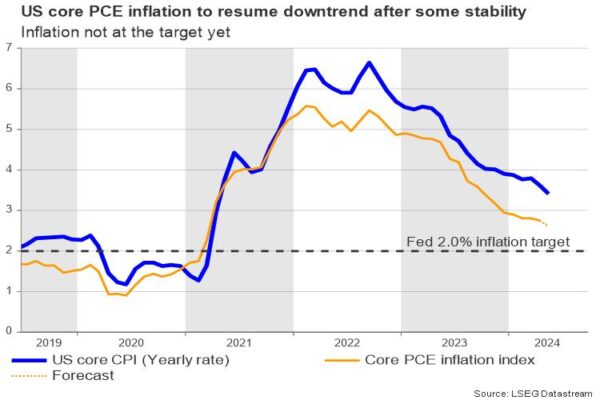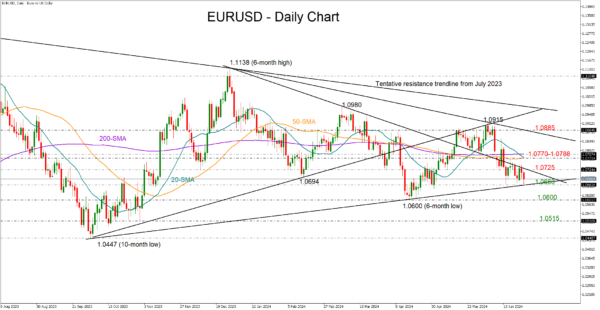- US core PCE inflation index could resume downtrend
- Fed may ask more evidence before cutting interest rates
- EURUSD trades near key support zone. Is it time for an upside reversal?
Inflation could hit a new low in May
Friday will see the release of the Fed’s favorite core PCE inflation measure at 12:30 GMT as the world’s largest central bank keeps looking for signs of sustained price stability around its 2.0% target almost a year after it paused its hiking cycle.
Forecasts point to a weaker reading of 2.6% year-on-year in May from 2.8% previously. If analysts are correct, the news could be meaningful to the Fed as this would be the lowest level reached since inflation accelerated from 1.9% to 3.1% in May 2021. The monthly increase could be a relief as well if it softens from 0.2% to 0.1%.
Will the data push for a rate cut?
The short answer is no. Recall that the latest CPI inflation report surprised slightly to the downside, increasing the chances of a September rate cut, but the details showed that there are still some areas such as the house/rental market which are stuck. Although the acceleration in interest rates sapped momentum in the house market and pushed housing inventory to the highest in two years recently, the house price index continued to rise at an unacceptable rate of 6.3% y/y.
Hence, even if the core PCE gauge resumes its downward pattern, policymakers would like to see one or two softer releases to consider a rate cut in September. Falling personal spending and income data could provide more incentives to lower borrowing costs, but analysts estimate a slight pickup to 0.3% m/m and 0.4% m/m, respectively.
Note that Fed policymakers lowered their rate projections from three rate cuts in March to only one for 2024, and some policymakers, including the board member Michelle Bowman, insist that reductions will not happen this year as upside inflation risks persist.
How will the data influence market sentiment?
Some volatility is expected following the release of the data as investors have downgraded their rate forecasts to 45 bps of monetary easing, and are currently thinking that a reduction in September could be a close call. Therefore, a negative surprise in the core PCE inflation data and signs of decelerating consumption could see more investors backing a September rate cut, especially as November’s general election approaches. In this case, EURUSD could set a strong footing near the key support trendline at 1.0660 and head towards its simple moving averages (SMAs) located within the 1.0770-1.0788 zone if the 1.0725 constraining zone gives the green light on the upside.
Alternatively, hotter-than-expected readings might increase fears that policy divergence between the Fed and other major central banks could widen in the coming months. As a result, the US dollar could benefit from the news, pressing EURUSD below 1.0660 and towards the 1.0600 round level. A more aggressive decline could lead the pair into the 1.0500-1.0515 support region.














